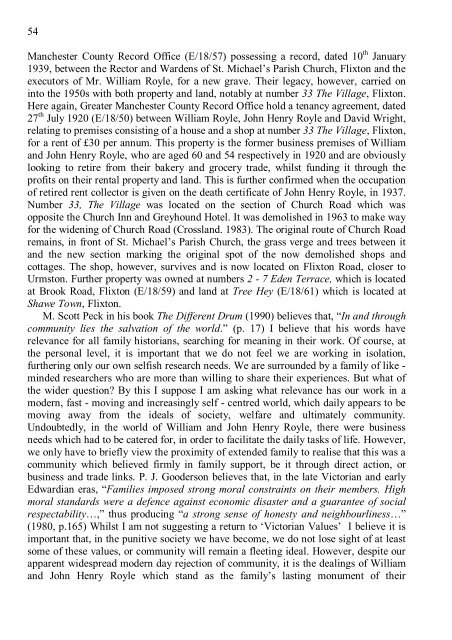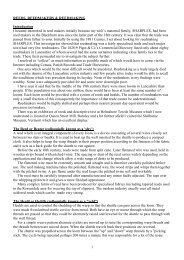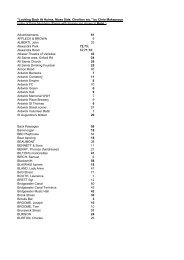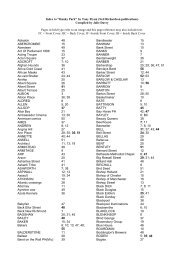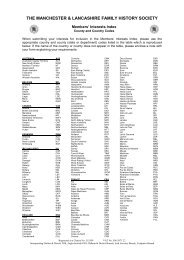The Roles of William and John Henry Royle in the Development of ...
The Roles of William and John Henry Royle in the Development of ...
The Roles of William and John Henry Royle in the Development of ...
Create successful ePaper yourself
Turn your PDF publications into a flip-book with our unique Google optimized e-Paper software.
54<br />
Manchester County Record Office (E/18/57) possess<strong>in</strong>g a record, dated 10 th January<br />
1939, between <strong>the</strong> Rector <strong>and</strong> Wardens <strong>of</strong> St. Michael’s Parish Church, Flixton <strong>and</strong> <strong>the</strong><br />
executors <strong>of</strong> Mr. <strong>William</strong> <strong>Royle</strong>, for a new grave. <strong>The</strong>ir legacy, however, carried on<br />
<strong>in</strong>to <strong>the</strong> 1950s with both property <strong>and</strong> l<strong>and</strong>, notably at number 33 <strong>The</strong> Village, Flixton.<br />
Here aga<strong>in</strong>, Greater Manchester County Record Office hold a tenancy agreement, dated<br />
27 th July 1920 (E/18/50) between <strong>William</strong> <strong>Royle</strong>, <strong>John</strong> <strong>Henry</strong> <strong>Royle</strong> <strong>and</strong> David Wright,<br />
relat<strong>in</strong>g to premises consist<strong>in</strong>g <strong>of</strong> a house <strong>and</strong> a shop at number 33 <strong>The</strong> Village, Flixton,<br />
for a rent <strong>of</strong> £30 per annum. This property is <strong>the</strong> former bus<strong>in</strong>ess premises <strong>of</strong> <strong>William</strong><br />
<strong>and</strong> <strong>John</strong> <strong>Henry</strong> <strong>Royle</strong>, who are aged 60 <strong>and</strong> 54 respectively <strong>in</strong> 1920 <strong>and</strong> are obviously<br />
look<strong>in</strong>g to retire from <strong>the</strong>ir bakery <strong>and</strong> grocery trade, whilst fund<strong>in</strong>g it through <strong>the</strong><br />
pr<strong>of</strong>its on <strong>the</strong>ir rental property <strong>and</strong> l<strong>and</strong>. This is fur<strong>the</strong>r confirmed when <strong>the</strong> occupation<br />
<strong>of</strong> retired rent collector is given on <strong>the</strong> death certificate <strong>of</strong> <strong>John</strong> <strong>Henry</strong> <strong>Royle</strong>, <strong>in</strong> 1937.<br />
Number 33, <strong>The</strong> Village was located on <strong>the</strong> section <strong>of</strong> Church Road which was<br />
opposite <strong>the</strong> Church Inn <strong>and</strong> Greyhound Hotel. It was demolished <strong>in</strong> 1963 to make way<br />
for <strong>the</strong> widen<strong>in</strong>g <strong>of</strong> Church Road (Crossl<strong>and</strong>. 1983). <strong>The</strong> orig<strong>in</strong>al route <strong>of</strong> Church Road<br />
rema<strong>in</strong>s, <strong>in</strong> front <strong>of</strong> St. Michael’s Parish Church, <strong>the</strong> grass verge <strong>and</strong> trees between it<br />
<strong>and</strong> <strong>the</strong> new section mark<strong>in</strong>g <strong>the</strong> orig<strong>in</strong>al spot <strong>of</strong> <strong>the</strong> now demolished shops <strong>and</strong><br />
cottages. <strong>The</strong> shop, however, survives <strong>and</strong> is now located on Flixton Road, closer to<br />
Urmston. Fur<strong>the</strong>r property was owned at numbers 2 - 7 Eden Terrace, which is located<br />
at Brook Road, Flixton (E/18/59) <strong>and</strong> l<strong>and</strong> at Tree Hey (E/18/61) which is located at<br />
Shawe Town, Flixton.<br />
M. Scott Peck <strong>in</strong> his book <strong>The</strong> Different Drum (1990) believes that, “In <strong>and</strong> through<br />
community lies <strong>the</strong> salvation <strong>of</strong> <strong>the</strong> world.” (p. 17) I believe that his words have<br />
relevance for all family historians, search<strong>in</strong>g for mean<strong>in</strong>g <strong>in</strong> <strong>the</strong>ir work. Of course, at<br />
<strong>the</strong> personal level, it is important that we do not feel we are work<strong>in</strong>g <strong>in</strong> isolation,<br />
fur<strong>the</strong>r<strong>in</strong>g only our own selfish research needs. We are surrounded by a family <strong>of</strong> like -<br />
m<strong>in</strong>ded researchers who are more than will<strong>in</strong>g to share <strong>the</strong>ir experiences. But what <strong>of</strong><br />
<strong>the</strong> wider question? By this I suppose I am ask<strong>in</strong>g what relevance has our work <strong>in</strong> a<br />
modern, fast - mov<strong>in</strong>g <strong>and</strong> <strong>in</strong>creas<strong>in</strong>gly self - centred world, which daily appears to be<br />
mov<strong>in</strong>g away from <strong>the</strong> ideals <strong>of</strong> society, welfare <strong>and</strong> ultimately community.<br />
Undoubtedly, <strong>in</strong> <strong>the</strong> world <strong>of</strong> <strong>William</strong> <strong>and</strong> <strong>John</strong> <strong>Henry</strong> <strong>Royle</strong>, <strong>the</strong>re were bus<strong>in</strong>ess<br />
needs which had to be catered for, <strong>in</strong> order to facilitate <strong>the</strong> daily tasks <strong>of</strong> life. However,<br />
we only have to briefly view <strong>the</strong> proximity <strong>of</strong> extended family to realise that this was a<br />
community which believed firmly <strong>in</strong> family support, be it through direct action, or<br />
bus<strong>in</strong>ess <strong>and</strong> trade l<strong>in</strong>ks. P. J. Gooderson believes that, <strong>in</strong> <strong>the</strong> late Victorian <strong>and</strong> early<br />
Edwardian eras, “Families imposed strong moral constra<strong>in</strong>ts on <strong>the</strong>ir members. High<br />
moral st<strong>and</strong>ards were a defence aga<strong>in</strong>st economic disaster <strong>and</strong> a guarantee <strong>of</strong> social<br />
respectability…,” thus produc<strong>in</strong>g “a strong sense <strong>of</strong> honesty <strong>and</strong> neighbourl<strong>in</strong>ess…”<br />
(1980, p.165) Whilst I am not suggest<strong>in</strong>g a return to ‘Victorian Values’ I believe it is<br />
important that, <strong>in</strong> <strong>the</strong> punitive society we have become, we do not lose sight <strong>of</strong> at least<br />
some <strong>of</strong> <strong>the</strong>se values, or community will rema<strong>in</strong> a fleet<strong>in</strong>g ideal. However, despite our<br />
apparent widespread modern day rejection <strong>of</strong> community, it is <strong>the</strong> deal<strong>in</strong>gs <strong>of</strong> <strong>William</strong><br />
<strong>and</strong> <strong>John</strong> <strong>Henry</strong> <strong>Royle</strong> which st<strong>and</strong> as <strong>the</strong> family’s last<strong>in</strong>g monument <strong>of</strong> <strong>the</strong>ir


